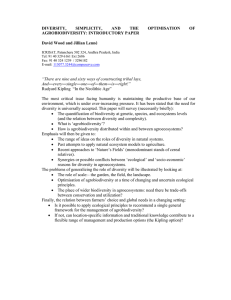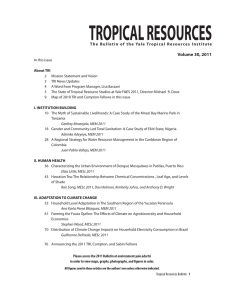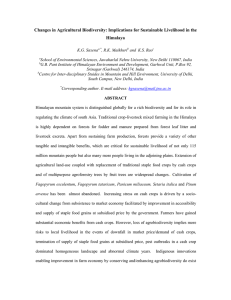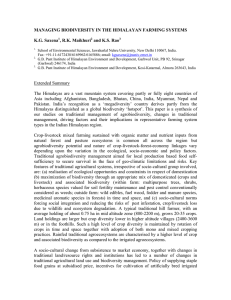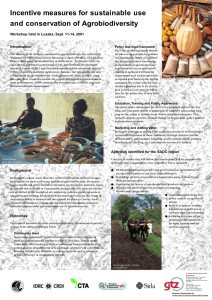Document 11492849
advertisement
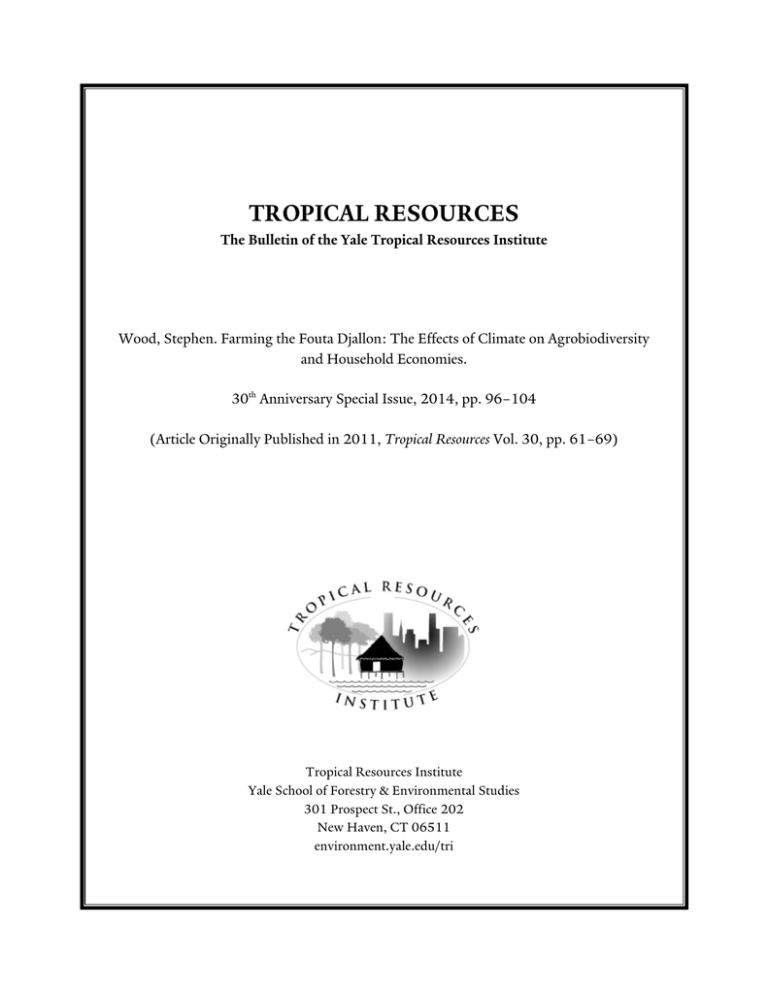
TROPICAL RESOURCES The Bulletin of the Yale Tropical Resources Institute Wood, Stephen. Farming the Fouta Djallon: The Effects of Climate on Agrobiodiversity and Household Economies. 30th Anniversary Special Issue, 2014, pp. 96–104 (Article Originally Published in 2011, Tropical Resources Vol. 30, pp. 61–69) Tropical Resources Institute Yale School of Forestry & Environmental Studies 301 Prospect St., Office 202 New Haven, CT 06511 environment.yale.edu/tri Article Originally Published in 2011, Tropical Resources Vol. 30, pp. 61–69 Farming the Fouta Djallon: The Effects of Climate on Agrobiodiversity and Household Economies by Stephen Wood, MESc 2011 Abstract The Fouta Djallon is a region of northern Guinea and southern Senegal that contains a dramatic topographically-driven climate gradient over a relatively small land area. Despite this variation in climate, the region is inhabited by a single dominant ethnic group whose agricultural and land use practices are fairly common across the area. The natural climatic variation in the Fouta Djallon paired with fairly uniform agricultural and natural resource use creates a natural experiment in which to explore the effects of differences in climate— which vary across the region—on agriculture and household economies. In this paper I use an original data set to study the effects of a variation in climate on agricultural biodiversity and household economies. Introduction Research in the climate sciences shows, almost unequivocally, a change in global climate by 2100. Though the precise pattern of this change is not certain, some warming is expected (IPCC 2001, IPCC 2007). Given this likelihood, it is important to ask what the effects will be on humanity’s well-being and the ecosystems on which we depend. Poor communities are particularly vulnerable to climate change, given their sparse economic resources available to invest in adaptation. These communities, especially in developing countries, are often engaged in economic activities that are directly affected by changes in climate. More than any continent, Africa’s population is at risk from climate change Stephen Wood is a PhD student in the Department of Ecology, Evolution, and Environmental Biology at Columbia University. He earned an MESc from the Yale School of Forestry and Environmental Studies in 2011. Originally from Needham, MA, he holds a BA from the George Washington University. Before Yale he served as an agriculture extension agent for the US Peace Corps in southeastern Senegal, and has worked for the Brookings Institution in Washington, DC. Thirtieth Anniversary Special Issue due to dependence on vulnerable economic sectors; much of the continent’s population lives in rural areas and depends on agriculture (Jaeger 1991). It is now apparent that changes in climate negatively affect African agriculture at the continental level (Kurukulasuriya et al. 2006, Schlenker and Lobell 2010). These results hold for high-resolution, national-level studies in South Africa and Cameroon (Deressa et al. 2005, Gbetibouo and Hassan 2005, Molua 2009), though the direct mechanism through which climate affects agricultural profitability is not clear. Though national level studies give insight into dynamics that continent-wide analyses might miss, analysis at the national level in Africa may miss important sub- and international factors, such as ethnicity. Countries tend to be bad proxies for cultural groups; the borders established in the colonial era reflect colonial economic interests more than real cultural, ethnic, or geographic divisions. Subnational studies of the effect of climate on agriculture have not been conducted in Africa because the variation needed to conduct such a study generally occurs on a large spatial scale. In this study, I use an original, sub-national Tropical Resources Bulletin 96 Stephen Wood (2011) Figure 1. Map of the study area. data set for a region of northern Guinea and southern Senegal with a drastic climate gradient to examine a hypothesis for the mechanism of the effect of climate on household economies. I posit that climate negatively affects agricultural biodiversity, which positively determines household well-being (Cavatassi et al. 2011, Netting 1993:146-156) as well as providing public benefits, such as genetic resources for seed breeding or developing medicines (Heal et al. 2004, Oldfield 1989). The natural topographical and climatic variabilities within the study zone capture the effects of changes between climate zones on agricultural biodiversity while other important factors remain constant, such as ethnicity. Conceptual Model Much prior research on the effect of climate on agricultural profitability in Africa has employed a Ricardian model. This Ricardian approach improves upon previous production Thirtieth Anniversary Special Issue function models by allowing farmers to adjust their crop choices over time and in response to a difference in climate, thus maximizing revenue. The production function approach, because it ignored crop transitions, overvalued the damages to agriculture from climate change. According to theory, each farmer will maximize net revenue given various exogenous constraints on his farm, such as climate and soils. The farmer will choose a particular crop and inputs that maximize net revenue for their land. This is given as: where R is annual net revenue, P_qi is the market price for crop i, Q_i is a production function for crop i, for which X_i is a vector of inputs, such as seed and fertilizer, L_i is a vector of labor (hired and owned), K_i is a vector of capital, such as plows, C is a vector of climate Tropical Resources Bulletin 97 Stephen Wood (2011) variables, S is a vector of soil characteristics, G is a vector of socioeconomic variables, P_x is the price for inputs X, and P_l is the price for labor L (Mendelsohn et al. 1994, Seo and Mendelsohn 2008, Wang et al. 2009). The goal of the Ricardian technique is to look at changes in net revenue of land for agricultural land across climatic gradients, particularly variation in temperature and precipitation. I use a similar hedonic-based approach to study the effects of climate on agrobiodiversity by substituting three measures of crop diversity: the number of crops grown, number of varieties known, and number of varieties grown, for net revenue. I apply similar control variables to the regressions for agrobiodiversity. I then regress net revenue on the three measures of agrobiodiversity to test the hypothesis that increased on-farm diversity is associated with higher household well-being (Cavatassi et al. 2011, Netting 1993). Data and Methodology I used a spatially explicit data set of 127 farmers collected from 38 villages. Sixteen villages are from the prefecture of Mali in northern Guinea, four villages were from the region of Tambacounda in eastern Senegal, and the remaining 18 villages were from the region of Kedougou in Senegal (figure 1). The surveys were conducted between June and September 2010. Although this is the most difficult time of year to access villages and many farmers are busy working in their fields, we were able to collect data on all of the sales from previous harvests. Had we conducted the survey at the height of the dry season, we would not have had information on the large amount of goods sold to buy materials for planting early in the rainy season. The surveys were conducted by the author with the help of two research assistants, one based in the town of Kedougou, Senegal and the other based in Mali, Guinea. The villages surveyed span a topographical, ecological, and climatic gradient, ranging in elevation from sea level to 1,300m, in mean annual temperature from 17°C to 30°C, and in precipitation from 400mm per year to Mean%Growing%Season%Temperature%(°C) 2003:2009 Kedougou Maali May$$$$$$$$ June$ $ $ $$July$$ $ $$Aug$$ $ $$Sept$ $ $ Oct Figure 2. Monthly temperatures of the study sites. Thirtieth Anniversary Special Issue Tropical Resources Bulletin 98 Stephen Wood (2011) Mean%Growing%Season%Precipitation%(mm) 200072009 Maali Kedougou Figure 3. Monthly precipitation at the study sites 2,000mm per year (figures 2 and 3). The study zone was stratified into three zones along this ecological gradient. Koussanar is the furthest north in Senegal and has a Sahelian climate and topography: it is flatter, hotter, and drier than the region of Kedougou in southern Senegal. Kedougou shares the border with Guinea, has a slightly higher elevation of about 300m and has higher precipitation than Koussanar, although temperature is similar. The prefecture of Mali in northern Guinea reaches an altitude of 1,300m. Precipitation in Mali is much higher than in Kedougou and temperatures are much lower (figures 2 and 3). The surveyed villages were selected at random from regional village lists provided by local health workers and agricultural extension agents. These lists are more thorough and up-todate than the existing government lists, which exclude smaller villages and seasonal farming communities. In each community, the chief of the Thirtieth Anniversary Special Issue village was asked to identify two large volume farmers and two small volume farmers as well as one average farmer to be surveyed. Farmers were surveyed as long as a minimum of three identified farmers were available. If the minimum number were not available, the surveyors returned later in the day or at another date. The survey included questions on production levels, inputs, demography, local infrastructure, soil, environmental change, wage rates, and other socio-economic variables. Climate data were taken from weather stations throughout the study zone. These data, while fairly precise, are somewhat inconsistently recorded and span only a five year period. These data, therefore, are supplemented with temperature and precipitation data from the African Rainfall and Temperature Evaluation System (ARTES) (World Bank 2003). Previous studies have divided climate data according to the four seasons that are familiar in the northeast United States. In this study Tropical Resources Bulletin 99 Stephen Wood (2011) zone, however, there are three seasons, only two of which are arguably relevant: the rainy season and the dry season. Climate data were categorized according to these seasons, since the climate data generally exhibit collinearity between months (Mendelsohn et al. 1994). Previous climate studies in Africa have faced the challenge of trying to compare seasons across the equator (Kurukulasuriya et al. 2006). This relative seasonal simplicity is an advantage of this study. The analysis of climate in these data was based solely on temperature. Precipitation has an obvious effect on agriculture, but was excluded from the analysis because of correlation with temperature. This correlation is due to the fact that the climate difference between southern Senegal and northern Guinea is driven exclusively by a topographical gradient. Results Using three separate measures of agrobiodiversity—number of crops grown, total varieties known, and total varieties grown—I find that climate has a strongly significant impact on the level of biodiversity on a farm in the study area. For the number of crops grown, I find that a ten degree increase in temperature is associated with an increase in one and a half crops, controlling for the number of children in school—a proxy for household well-being – and whether or not the farm is on a hill—a proxy for the quality of the land (table 1). For the number of total varieties known, I find that a ten degree increase in temperature is associated with an increase in 4.1 varieties known, using the same control variables (table 1). For the number of varieties grown, I find that an increase in ten degrees is associated with an increase in 1.3 total varieties grown (table 1), using the same control. Although the effect of temperature on crop diversity is highly significant, the effect of precipitation is not. This is shown in the regression tables. Also, consistent with some of the anthropological literature on crop diversity, I find that higher crop diversity is clearly and (1) numberCropsGrown 0.154 (0.0296) meanStationPrecip 0.00107 (0.000555) kidsInSchool 0.0889 (0.0344) farmOnHill 0.830 (0.188) Constant -2.443 (1.354) Observations 127 R-squared 0.357 Robust standard errors reported in parentheses Key covariates in bold VARIABLES meanStationTemp (2) totalVarsKnown 0.410 (0.115) 0.00293 (0.00224) 0.278 (0.176) 1.364 (0.723) -7.453 (5.225) 116 0.187 (3) totalVarsGrown 0.130 (0.0671) -9.63e-05 (0.00107) 0.307 (0.1000) 1.157 (0.525) -0.0128 (2.752) 89 0.196 Table 1. Effects of climate on agrobiodiversity. The table shows the effect of a unit increase in the independent variables in the first column on three dependent variables (columns 2-4), each of which is a different measure of agrobiodiversity. Results in bold indicate key results of the effect of temperature on agrobiodiversity. Thirtieth Anniversary Special Issue Tropical Resources Bulletin 100 Stephen Wood (2011) Table 2. Effects of agrobiodiversity on net revenue, reported in the West African CFA franc. The table shows the effect of a unit increase in the independent variables in the first column on net agricultural revenue. Columns 2-4 each represent a different model specification, each with a different measure of agrobiodiversity. Results in bold indicate key results of the effect of agrobiodiversity on net revenue. VARIABLES numberCropsGrown Guinea householdsInCommunity timeToClosestMarket agWorkersInHH totalVarsKnown (1) Net Revenue 54,562 (25,574) 133,674 (47,289) 1,630 (750.7) 1,078 (456.4) 28,683 (8,813) (2) Net Revenue (3) Net Revenue 152,753 (50,612) 1,656 (794.4) 1,396 (474.7) 25,791 (8,115) 23,580 (7,397) 92,812 (63,702) 1,875 (1,087) 1,046 (553.5) 24,461 (12,269) totalVarsGrown Constant -355,773 (126,506) Observations 96 R-squared 0.329 Robust standard errors reported in parentheses Key covariates in bold significantly associated with higher incomes. For an increase in one crop grown, there is an associated increase in annual net revenue of $100 US (table 2). An increase in one variety known about is associated with an increase in annual net revenue of $50 US (table 2). And an increase in one variety grown is associated with an increase in annual net revenue of $50 US (table 2). All of these analyses control for country, village size, the time required to travel to the nearest market, and household labor supply. Discussion The primary finding that higher mean temperature is associated with greater agrobiodiversity may seem to be counterintuitive. One might think that more temperate climates would be able to support a Thirtieth Anniversary Special Issue -380,219 (125,875) 87 0.358 26,832 (12,969) -247,651 (115,426) 68 0.302 wider range of crops and, thus, have higher crop diversity. These results show, however, that in warmer climates a wider range of crops are grown and, less significantly, a wider range of varieties. Why might a warmer climate support a wider range of crops? One possible explanation is that very few farmers in northern Guinea grow millet and sorghum varieties because it is too cool and dry. Also, the wide variety of agroecological zones in northern Guinea—within the same climate zone—mean that although there is a wide variety of crops grown in northern Guinea, any given farmer is quite specialized in the crops that are within his agroecological zone. Another possible explanation is that farmers in southern Senegal could be growing more crops in order to buffer against shock—in a warmer region, seasonal temperature increases might be more likely to negatively affect some crops, in Tropical Resources Bulletin 101 Stephen Wood (2011) Photograph 1. A farmer in his carrot and parsnip garden in Medina, Senegal. which case it would be advantageous to have a wider variety of crops. More research in the social and natural sciences needs to be done to determine the precise explanation of the direct effect of climate on agrobiodiversity. The observed effect of climate on agrobiodiversity could also be an indirect effect, due to unobserved factors that co-vary with climate. For instance, Senegal is warmer than Guinea, but it also happens to be more economically developed. Because Senegal has more developed market infrastructure, there is a greater number of crops with higher economic value. Farmers therefore choose more diversity on their farm in order to maximize their net revenue. I controlled for this effect, to some extent, by including a measure of household well-being: the number of children in school. There is likely, however, a stillunobserved effect of economic development on agrobiodiversity that is independent of the number of children in school. Although there is a clear and significant relationship between climate and temperature, it is not clear to what extent the relationship is driven by climate per se or by factors that co-vary with Thirtieth Anniversary Special Issue climate, such as economic development. After controlling for some of the differences in economic development, there is strong reason to think that climate does play a role, in and of itself, on agricultural diversity. However, it is likely that there is an as-of-yet unobserved effect of climate covariates on agrobiodiversity. Future research in economics and ecology needs to be done in order to tease out more precisely the relative effects of climate per se and economic development on agrobiodiversity. The effect of agrobiodiversity on household economies, however, is clear and significantly positive. Depending on the measure of crop diversity, an increase in one more crop or crop variety is associated with an annual increase in net revenue of between $50 and $100 USD. By contrast, the negative effect of climate on net revenue is predicted to be around $28 USD per annum (Kurukulasuriya et al. 2006). Increasing on-farm diversity, therefore, could be an effective tool for climate adaptation. Conclusion If a change in global and local climates is expected in the future, decision makers Tropical Resources Bulletin 102 Stephen Wood (2011) need to think carefully about how to protect the most vulnerable populations to these changes. For small-scale West African farmers, climate adaptation programs have focused on diversifying revenue developing agricultural practices and inputs that are less sensitive to climate variability than traditional practices. The results from this paper show that increasing on-farm diversity could be an effective strategy for adapting to climate change. It is unlikely, however, that species richness itself matters as much as increasing the number of crops that play important functional roles, such as nitrogen fixation or drought resistance. More research is needed in both the natural and social sciences to determine what the important functional roles are in this agroecosystem, how local communities value them, and how they are likely to change with climate. Acknowledgements This research would not have been possible without the support of the Tropical Resources Institute at Yale, the Lindsay Fellowship for African Studies at the Yale MacMillan Center, and the Agrarian Studies Program at Yale. For support in developing the project, I owe thanks to Doug Gollin, Robert Mendelsohn, Cheryl Doss, Melinda Smale, Xuhui Lee, and Jonathan Richardson. Also, thanks to Geofrey Mwanjela and members of the Environment in Africa Research Group at Yale for feedback on various iterations of the research. I would also like to thank those who attended and offered feedback at a talk I gave on this project at the Yale Council on African Studies in November 2010. Finally, thank you to Ryan Sarsfield and Lisa Bassani at TRI for reading and providing feedback on drafts of this paper. References Cavatassi, R., L. Lipper, and U. Narloch. 2011. Modern variety adoption and risk management in drought prone areas: insights from the sorghum farmers of eastern Ethiopia. Agricultural Economics 42. Thirtieth Anniversary Special Issue Deressa, T., Rashid M. Hassan and D. Poonyth. 2005. Measuring the Impact of Climate Change on South African Agriculture: The Case of SugarCane Growing Regions. Agrekon 44. Gbetibouo, G.A. and R.M. Hassan. 2005. Measuring the economic impact of climate change on major South African field crops: a Ricardian approach. Global and Planetary Change 47: pp. 143-152. Heal et al. 2004. Genetic diversity and interdependent crop choices in agriculture. Resource and Energy Economics 26: pp. 175-184. IPCC. 2001. Impacts, Adaptation, and Vulnerability, in Climate Change 2001. Contribution of Working Group II to the Third Assessment Report of the Intergovernmental Panel on Climate Change (IPCC), eds. J. McCarthy, O. Canziani, N. Leary, D. Dokken and K. White,. Cambridge, UK: Cambridge University Press. IPCC. 2007. Summary for Policymakers, in Climate Change 2007: The Physical Science Basis. Contribution of Working Group I to the Fourth Assessment Report of the Intergovernmental Panel on Climate Change, eds. S. Solomon, D. Qin, M. Manning, Z. Chen, M. Marquis, K.B. Averyt, M. Tignor and H.L. Miller. Cambridge, UK: Cambridge University Press. Jaeger, W. 1991. The impact of policy in African agriculture: an empirical investigation. Policy Research Working Paper Series. Washington, D.C.: The World Bank. Kurukulasuriya, P., R. Mendelsohn, R. Hassan, J. Benhin, T. Deressa, M. Diop, H.M. Eid, K.Y. Fosu, G. Gbetibouo, S. Jain, A. Mahamadou, R. Mano, J. Kabubo-Mariara, S. El-Marsafawy, E. Molua, S. Ouda, M. Ouedraogo, I. Sene, D. Maddison, S.N. Seo and A. Dinar. 2006. Will African agriculture survive climate change? World Bank Economic Review 20, pp. 367388. Mendelsohn, R., W.D. Nordhaus and D. Shaw. 1994. The Impact of Global Warming on Agriculture - a Ricardian Analysis. American Economic Review 84, pp. 753-771. Tropical Resources Bulletin 103 Stephen Wood (2011) Molua, E.L. 2009. An empirical assessment of the impact of climate change on smallholder agriculture in Cameroon. Global and Planetary Change 67, pp. 205-208. Netting, R. 1993. Smallholders, householders: farm families and the ecology of intensive, sustainable agriculture. Stanford, CA: Stanford University Press. Oldfield, M. 1989. The Value of Conserving Genetic Resources. Sunderland, MA: Sinauer Associates. Schlenker, W. and D. Lobell. 2010. Robust negative impacts of climate change on African agriculture. Environmental Research Letters 5. Seo, S.N. and R. Mendelsohn. 2008. A Ricardian analysis of the impact of climate change on South American farms. Chilean Journal of Agricultural Research 68, pp. 69-79. Wang, J.X., R. Mendelsohn, A. Dinar, J.K. Huang, S. Rozelle and L.J. Zhang. 2009. The impact of climate change on China’s agriculture. Agricultural Economics, 40, pp. 323-337. World Bank. 2003. African Rainfall and Temperature Evaluation System (ARTES). Washington, D.C.. Thirtieth Anniversary Special Issue Tropical Resources Bulletin 104
